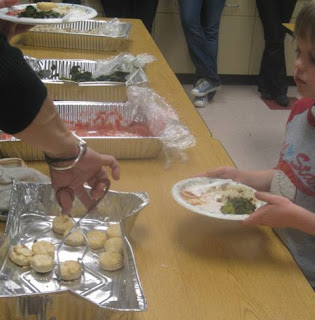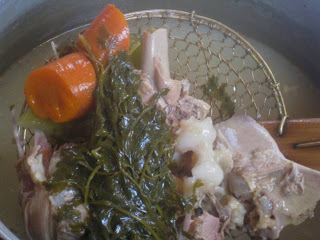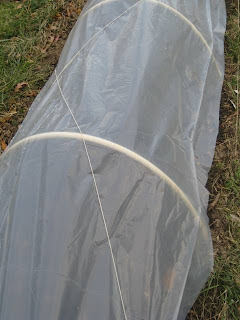 Here's an old-fashioned pleasure: shelling beans.
Here's an old-fashioned pleasure: shelling beans.We grew a hefty crop of lima beans in a our kitchen garden here in the District of Columbia, about a mile from the White House. I let them dry on the vine and finally just the other day got around to removing the beans from the pods.
I reckon most people have an image of something green and plump when they think of lima beans. But these--Jackson Wonder beans--are a mottled brown and cream color when they emerge from the pod. When cooked, they turn a solid brown. They are luxuriously meaty, and I can't think of a better place for them than in this quick "cassoulet."
A true cassoulet includes sausage and confit of duck and of course beans, all cooked in a lidded pot slowly for a long time. It's pure peasant food. My quick vegetarian version involves cooking the beans first, then baking them in the oven with bread crumbs. All the flavor comes from the beans, which makes this one of the world's finest bean dishes--flavorful and cheap. This time I used some of our own canned tomatoes, making it a very home-grown cassoulet. Then at the last minute I remembered that our friend Bob, on a recent visit from France, had brought us some canned confit.

Canned confit? Don't laugh. We're not usually into canned goods. And I just assumed this variety--Les Recettes de Maite--was the French equivalent of Dinty Moore or something. Just look at the picture of this woman on the label. Some merchandizer's fantasy of a French homemaker, no? But when I started snooping around on-line, I discovered the woman is real. She has a restaurant in a place called Rion des Landes in Southwestern France and apparently makes canned goods on the side. Which makes her closer to the equivalent of Lidia Bastianich--a confit capitalist. Check out her singing website.
In an interview with a French women's magazine, Maite declares that the Southwest has the best ingredients: meat, duck, foie gras. "And with that, you can make miracles." I had some doubts about the confit coming out Maite's can. How good could it possibly be? It's covered in great globs of fat. The meat itself--two large thighs--is shockingly pink and otherworldly looking. But baked with my beans....transcendental. You're eyes will roll back in your head and you would never guess it came out of a can.
So thanks, Bob, if you're reading this: We loved the canned confit.
To start, soak your dried beans overnight. (Use cannellini or Great Northern beans, or something similar, if you don't have these wondeful lima beans.) I had about two cups, and covered them with water in a large bowl to a depth of several inches. The following day I cooked them in a heavy pot with an onion, halved, 2 cloves of garlic, peeled and crushed, 2 bay leaves and a small fistful of fresh thyme sprigs. Cover everything generously with water and cook over moderate heat until the beans are tender, about an our. Drain the beans but save the cooking liquid. You can toss the onion, garlic, bay and thyme.
Next you will need a large onion, peeled and cut into small dice, along with three cloves of garlic chopped fine. Place these in a heavy pot over moderate heat with extra-virgin olive oil or, if you are planning to use confit, some of the duck fat. Season with salt and cook, covered, until the onion is soft and perhaps browned a little, about 10 minutes.
In a large bowl, mix the beans with the onion mixture and 1 pint of canned diced tomatoes. Add a tablespoon of finely chopped sage leaf. Mix everything together and season with salt and freshly ground black pepper as needed. Add pieces of confit, if using, and pour into a ceramic casserole.
Cover the bean mix with reserved bean cooking liquid if you remembered to save it or with chicken stock, preferably homemade. Top everything with a generous dusting of toasted bread crumbs (I used part of a Tuscan loaf from Whole Foods, crust removed and run through the food processor.)
Cover the casserole with aluminum foil and bake in a 425 degree oven until the cassoulet is bubbling, all the flavors have melded and the bread crumbs have begun to absorb some of the liquid, about 1 hour. You can serve this hot, or save it for another day. It will only get better with age.







 We were surprised to see the famous carousel outside the Smithsonian's castle-like headquarters building open for business on such a cold winter day. No waiting in line today. We couldn't resist taking a turn.
We were surprised to see the famous carousel outside the Smithsonian's castle-like headquarters building open for business on such a cold winter day. No waiting in line today. We couldn't resist taking a turn.








 And here is the arugula, always a pretty reliable
And here is the arugula, always a pretty reliable 


































